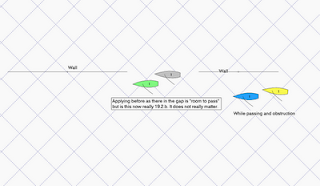Passing a Continuing Obstruction
(if you want to start from the beginning read LTW Q&A | 17 first)
I have been looking into this and am not sure we answered fully the questions posed by Sen.
- "She" is the boat that had been clear astern.
- The situation is when an overlap is created when passing a continuous obstruction. Strictly before could apply but when you are only approaching the test of there “being room to pass between them” is usually fulfilled. See old example in the old Elvstrom Rules books.
 I think there is a big change unless I am mistaken, or if I am, the new rule is more explicit.
I think there is a big change unless I am mistaken, or if I am, the new rule is more explicit.To me the old rule allows any boat RoW or other that gets and inside overlap to have the possibility of room if the test of “passing between the boat and obstruction is met”. This would have had to be the case under the old rules as at leeward marks a port boat had rights over a starboard boat when she was in the Zone. This was pure old RRS 18.
Now we have moved to RRS 19 and we can thus look a fresh not being tied by the old conventions. Thus for obstructions we see the Zone has gone. Further now there is an extra requirement in RRS 19.2.c in that it applies to a boat “clear astern and required to keep clear”.
If you are a ROW boat the rule does not apply and now (not perhaps previously) the clear ahead port boat has to move. This is a game change or clarification.
The additional words “While the boats remain overlapped, she shall keep clear and rules 10 and 11 do not apply” are now very important. If you now are on port as the boat clear astern of another port tack boat, then get an inside overlap, when you could not “have passed between them” you cannot gain ROW by gybing to starboard.
In similar fashion you cannot have no rights and gybe to become the leeward boat and claim ROW. If you agree, perhaps you could forward this to Sen for his consideration.
Mike Butterfield IRO IU IJ

What do you think?
.

With regard to the diagram above lets assume that Gray obtained the overlap with Green as shown in the diagram (between the two walls). Although Green has luffing rights does this in actual fact mean that Green has to give Gray room to fit between the upcoming obstruction and herself? (Assuming Grey has obtained the overlap and given Green enough room to keep clear).
ReplyDeleteThanks
Rowan
@Rowan
ReplyDeleteYes, Gray has the right to go between and Green must bear away at th upcoming obstruction. The rule works like this: At the moment an overlap is established, take a snap shot. Then freeze Green in that position. If Gray can sail in between Green and the obstruction with Green staying in that freezed position, she gains the right to do so, even if Green (unfreezed) has to make room later.
I know it's a different question but on the same Rule 19 ...
ReplyDeleteI have read somewhere else that this rule now means that at the start line a second row boat can put her nose between two front row boats and that the windward of the two front row boats now must move to keep clear, even if this means crossing the line before the starting signal.
Anybody like to comment on this?
The Hook. Sure - subject to rules 15 and 16.
ReplyDeleteWith regard to the continuing obstruction scenario diagrammed, rule 19 turns on when the boats are "at" an obstrction. Rule 19.2(c) only applies if the boats (plural) are "passing" a continuing obstruction. "passing" and "at" are not defined in the rules so ordinary and customary meanings apply. Are both boats "at" and "passing" the obstruction in the position frozen, or are they only "at" the obstruction? If both are passing the obstruction, 19.2(c) applies, if both are at but not passing the obstruction, 19.2(b) applies. If 19.2(c) applies there also must be room for the inside boat to pass between the outside boat and the obstruction to entitle inside boat to room.
ReplyDeleteThanks, but what is The Hook?
ReplyDeleteOtherwise known as a 'hook-up' when a boat establishes a controlling position by becoming overlapped close to leeward from astern, thus enabling her to push the windward boat around. Usually applied in Match Racing, before the start when there is no rule 17 proper course limitation.
ReplyDelete